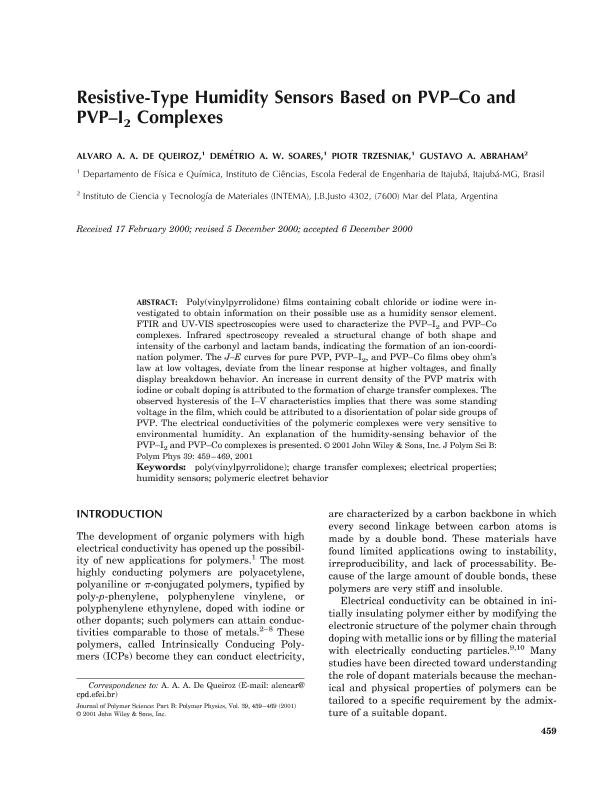Mostrar el registro sencillo del ítem
dc.contributor.author
De Queiroz, Angel A.A.
dc.contributor.author
Soares, Demetrio A.W.
dc.contributor.author
Tresniack, P.
dc.contributor.author
Abraham, Gustavo Abel

dc.date.available
2018-02-06T14:16:49Z
dc.date.issued
2001-01-11
dc.identifier.citation
De Queiroz, Angel A.A.; Soares, Demetrio A.W.; Tresniack, P.; Abraham, Gustavo Abel; Resistive-type humidity sensors based on PVP–Co and PVP–I2 complexes; John Wiley & Sons Inc; Journal of Polymer Science Part B: Polymer Physics; 39; 4; 11-1-2001; 459-469
dc.identifier.issn
0887-6266
dc.identifier.uri
http://hdl.handle.net/11336/35736
dc.description.abstract
Poly(vinylpyrrolidone) films containing cobalt chloride or iodine were investigated to obtain information on their possible use as a humidity sensor element. FTIR and UV-VIS spectroscopies were used to characterize the PVP–I2 and PVP–Co complexes. Infrared spectroscopy revealed a structural change of both shape and intensity of the carbonyl and lactam bands, indicating the formation of an ion-coordination polymer. The J–E curves for pure PVP, PVP–I2, and PVP–Co films obey ohm's law at low voltages, deviate from the linear response at higher voltages, and finally display breakdown behavior. An increase in current density of the PVP matrix with iodine or cobalt doping is attributed to the formation of charge transfer complexes. The observed hysteresis of the I–V characteristics implies that there was some standing voltage in the film, which could be attributed to a disorientation of polar side groups of PVP. The electrical conductivities of the polymeric complexes were very sensitive to environmental humidity. An explanation of the humidity-sensing behavior of the PVP–I2 and PVP–Co complexes is presented.
dc.format
application/pdf
dc.language.iso
eng
dc.publisher
John Wiley & Sons Inc

dc.rights
info:eu-repo/semantics/openAccess
dc.rights.uri
https://creativecommons.org/licenses/by-nc-sa/2.5/ar/
dc.subject
Poly(Vinylpyrrolidone)
dc.subject
Charge Transfer Complexes
dc.subject
Electrical Properties
dc.subject
Humidity Sensors
dc.subject
Polymeric Electret Behavior
dc.subject.classification
Físico-Química, Ciencia de los Polímeros, Electroquímica

dc.subject.classification
Ciencias Químicas

dc.subject.classification
CIENCIAS NATURALES Y EXACTAS

dc.subject.classification
Recubrimientos y Películas

dc.subject.classification
Ingeniería de los Materiales

dc.subject.classification
INGENIERÍAS Y TECNOLOGÍAS

dc.title
Resistive-type humidity sensors based on PVP–Co and PVP–I2 complexes
dc.type
info:eu-repo/semantics/article
dc.type
info:ar-repo/semantics/artículo
dc.type
info:eu-repo/semantics/publishedVersion
dc.date.updated
2018-02-02T19:44:29Z
dc.journal.volume
39
dc.journal.number
4
dc.journal.pagination
459-469
dc.journal.pais
Estados Unidos

dc.journal.ciudad
Nueva York
dc.description.fil
Fil: De Queiroz, Angel A.A.. Universidade Federal Itajuba; Brasil
dc.description.fil
Fil: Soares, Demetrio A.W.. Universidade Federal Itajuba; Brasil
dc.description.fil
Fil: Tresniack, P.. Universidade Federal Itajuba; Brasil
dc.description.fil
Fil: Abraham, Gustavo Abel. Consejo Nacional de Investigaciones Científicas y Técnicas. Centro Científico Tecnológico Conicet - Mar del Plata. Instituto de Investigaciones en Ciencia y Tecnología de Materiales. Universidad Nacional de Mar del Plata. Facultad de Ingeniería. Instituto de Investigaciones en Ciencia y Tecnología de Materiales; Argentina
dc.journal.title
Journal of Polymer Science Part B: Polymer Physics

dc.relation.alternativeid
info:eu-repo/semantics/altIdentifier/doi/http://dx.doi.org/10.1002/1099-0488(20010215)39:4<459::AID-POLB1019>3.0.CO;2-T
dc.relation.alternativeid
info:eu-repo/semantics/altIdentifier/url/http://onlinelibrary.wiley.com/doi/10.1002/1099-0488(20010215)39:4%3C459::AID-POLB1019%3E3.0.CO;2-T/abstract
Archivos asociados
